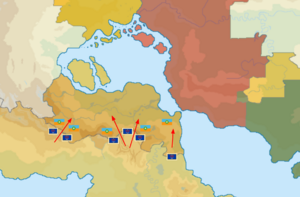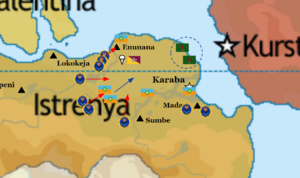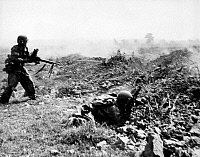Mosquito War
| Mosquito War | |||||||
|---|---|---|---|---|---|---|---|
| Part of the Occidental Cold War and the South Cronan Narco Wars | |||||||
| |||||||
| Belligerents | |||||||
|
|
Supported by: | ||||||
| Commanders and leaders | |||||||
|
|
| ||||||
| Strength | |||||||
|
Peak strength: (combat troops) |
Peak strength: (combat troops) | ||||||
| Casualties and losses | |||||||
|
|
| ||||||
The Mosquito War (Qabóri: Gerráq le Mosqítan) was a conflict which lasted from November 13, 1965, to the Dalton Accords in Alstin on August 7, 1970. The conflict mostly took place in Istrenya, however spillovers in Malentina and parts of northern Tierrador occurred. It is considered to be the second of the four South Cronan Narco Wars and a pivotal point in Tierrador's participation in the Occidental Cold War. The war was fought between Tierrador, led by Pedro Kintón, and Istrenya, led by newly-implemented leader Woko'eli Koko. The war is widely considered as a Proxy war, and lasted four years and three months, officially ending in 1970, by ruling of the Dalton Accords. This war was one of the costliest and most negatively-influential wars in Tierradorian history, spawning several domestic movements by Tierradorian civilians.
The Mosquito War was sparked by a longstanding territorial, economic, and political dispute between Tierrador and Istrenya over multiple reasons, including the presence of resource-rich border region known for its abundance of rare minerals and fertile land. The initial tensions dated back not very far, as Istrenya had come off defending their homeland from the NIPF, during the Istrenyan Crisis. Eventually, the Istrenyan government, which had been in major disputes with Kintón-led Tierrador, began authorizing military exercises within the Qalhéq Mountains, which marked the border between both nations. The Tierradorian government began accusing Istrenyan soldiers of regularly crossing into Tierrador and terrorizing small mountain villages. As diplomatic efforts failed to resolve the dispute, the situation escalated into a full-blown armed conflict. At the onset of the Mosquito War, there was widespread enthusiasm and support for the conflict among the Tierradorian population. The Tierradorian government unsuccessfully framed the war as a matter of national pride and territorial integrity. They employed ineffective propaganda campaigns, appealing to the patriotic sentiments of some of Tierrador's citizens, though others would quickly see through the façade. Despite, this, there was an initial surge in support which was reflected in high levels of volunteer enlistment, public rallies, and expressions of solidarity with the military.
Eventually, as the war raged on, and the surprise involvement of Arcerion in the war in 1967, domestic popularity drastically decreased for Tierradorians. The Tierrador Army advanced quite far into the Istrenyan homeland, taking around sixty-five percent of the nation. Istrenya’s response was the Benta Offensive, and while it was a tactical defeat for both Istrenya and Arcerion, it proved to be a strategic victory, as it began reducing the Tierradorian stranglehold on Istrenyan territory. This led to mass casualties on the Tierradorian side and caused domestic support for the war to dwindle. Over time, anti-war movements gained traction within Tierrador. These movements, led by the TPA, a group led by many concerned citizens, war veterans, and intellectuals, argued that the war caused ridiculously high amounts of unnecessary suffering, and that a peaceful resolution needed to be sought immediately, which were enforced by threats of violence from the TPA. The prolonged conflict also imposed a significant economic burden on Tierrador. The costs of financing the war, including funding the military, procuring weaponry, and maintaining infrastructure, began to strain the nation's economy. This led to tax hikes and reduced public spending on essential services.
As support dwindled, and international pressure from Alstin along with Levantine and Sarpedonian powers, Pedro Kintón and Woko'eli Koko eventually met in Dalton, Alstin for the Dalton Accords, which was officially signed on June 7, 1970, and began the withdrawing of Tierradorian personnel from Istrenya, thus ending the war by September 2, 1970.
Background
Istrenyan Crisis
Istrenya had been the center of a violent civil crisis, which saw many indigenous groups from the rural areas attempt to take control of the political landscape and promote indigenous nationalism through a communist revolt. However, with the support of Arcerion, the Istrenyan Government quickly shut down the communist insurgents. Following the civil conflict, Populist leader A'kale Treo resigned from his position as President of Istrenya. Throughout his presidency, Istrenya maintained strong relations with Arcerion and Tierrador, and allowed both nations to assist the Populist Militia during the Istrenyan Crisis. However, in Treo's place, Malentine-born Woko'eli Koko was appointed. Koko was an severely outspoken critic of the Woqalate, most notably due to the policies of Pedro Kintón which, in Treo's point of view, were seen as imperialistic and collectivist. In February 1964, Koko met with Kintón and Qaphenć Aphío A. Woderq in Taisgol to discuss the various political differences between the two nations. After the conference, it seemed as if the leaders came to an understanding of both nations' political standpoints. However, two months later, Koko officially severed ties with the Tierradorian Woqalate. This was a curveball to the Woqalate, as Istrenya also served as a strategic location for Arco-Tierradorian commerce and relations.
Illegal commerce and Šuhek Incident
For the majority of the 1964 calendar year, the rise of illegal commercial activity along the border of Tierrador and Istrenya was the cause for concern within both governments. Istrenyan state media accused the Woqalate of sponsoring illegal activity along the border, while Tierradorian outlets such as TBS and Tierrador Post claimed the opposite, accusing Koko and the Populist government of state-sponsored drug smuggling. It was proven that several categories of illegal narcotics, most notably Loa-originated copium, loreium, cocaine and amphetamines, however these were mostly from independent street gangs situated along the Qalhéq Mountains. Many consider this to be the root cause for the Mosquito War. Eventually, by mid-1965, the illegal commerce and ensuing conflicts escalated severely, leading to abnormally severe skirmishes along the Qalhéq border. The conflicts would become entwined with the South Cronan Narco Wars, with some scholars claiming these activities, along with the Akwachee War, as the beginning of the South Cronan Narco Wars.
The Šuhek Incident occurred in June 1965, and was considered the "final straw" for the Woqalate. The Qanačee Commerce Group, a Populist-funded paramilitary cartel, invaded the small Tierradorian exclave of Šuhek and held the residents of the town hostage for several months. The 1,500 residents of the small mountain community were confined to their homes for nearly four months, only being allowed outside for essential needs, such as food or medical needs. Two weeks later, the TDF's Mountain Patrol Authority swarmed into Šuhek and forced the QCG out.
More attacks took place from July to October 1965
War was declared in November 1965
Woderq didn’t want to invade Istrenya but Kintón did
Qangreč fought against it but the public was in favor so it was no use
Šaphiana's escalation
Following the death of Woderq in 1966, Pedro Kintón appointed Qangreč member Daniel W.K. Šaphiana as the Qaphenć of Tierrador. Unlike Woderq, who wished to only act in defense, Šaphiana was heavily against Koko and the Populist government. Kintón was more fond of Šaphiana’s approach to the war, as he was more open to new military strategies which soon proved effective throughout the war.

Tierradoran Invasion
Rout at Mogtopeni
1st, 2nd, and 4th Istrenyan Divisions had been completely destroyed in the retreat from Mogtepeni
Winter of 1966
1967 Tierradoran Offensive
Inconclusive, unable to close the IUZ Pocket
Arcer Involvement
Arcerion long held close economic and political ties with Istrenya, notably and most recently with the Arcer involvement in the Istrenyan Crisis preventing a communist takeover of the country in 1961. Public support for another war in Istrenya was low in Arcerion, however the government saw the encroachment on the Arcosphere as critical issue, and with the Fourth Bush War raging in Northern Arcerion, the Confederate Parliament saw this as a further degradation of Arcerion's ability to project its sovereignty and protect its economic interests in the Malentine Basin.

Istrenyan Unoccupied Zone
By early 1967, the situation along what was now coined the 'Istrenyan Unoccupied Zone' was growing increasingly dire. Refugees had been packed in by the tens of thousands, and illegal crossings of the Warrington Strait were at an all time high. Prime Minister of Arcerion, Kian Fleming, announced a special committee to convene in parliament and come up with solutions on diplomatic resolutions, including entreating the League of Nations to attempt a ceasefire to give the beleaguered Armed Forces of Istrenya a chance to organize and for humanitarian corridors to be established, therefore with the hope that a lessening of refugees would poor across the Songun Sea and into Arcerion's Southern Marches. Sadly, there was little intervention from the League of Nations as Arcerion was already deeply involved in a multi-front conflict of increasing scale in the Fourth Arcer Bush War along the Northern border of Arcerion.
Within the Istrenyan Unoccupied Zone (IUZ), the humanitarian situation was growing worse with every passing week. Artillery and air strikes had damaged critical infrastructure such as water filtration plants, waste removal services, hospitals, the power grid, as well as other critical government services such as radio and television. With an inability to communicate with the populace, the Istrenyan Government was struggling to maintain order within the IUZ as much as outside of it. The Arcer government, seeing the situation worsen, formulated a response after convening the Arcer General Staff to provide insight into the military situation. The report, based off of intelligence gained by the Office of Public Safety and National Security and the Defense Attache at the Arcer Embassy, reflected the poor situation. The Government forces, which had only slightly recovered from the Istrenyan Crisis, had withdrawn largely to within the IUZ. The 1st, 2nd, and 4th Istrenyan Divisions had been completely destroyed in the retreat from Mogtepeni, a major blow for morale and cohesion of the remaining Istrenyan forces. Elements of the Istrenyan 2nd Corps were desperately holding a city under siege in the defense of the capital Karaba, and the loss of Madara, a major economic city on the Songun, had cut Istrenya off from the sea. The remaining elements of the frail Istrenyan 1st Corps were holding a fragile line along the river lands, anchored in the North at Enunana. Opposite them, were fresh Tierradoran forces, which while relatively inexperienced due to a lack of major campaigns in recent decades had the initiative, numbers and morale advantage over their diminished Istrenyan enemy.
Ængle Red Line
Arcerion, via the Paulastran ambassador to Arcerion, issued a comminque to Tierrador, with who they had no formal relationship or consular office with. The communique outlined the so called 'Ængle Red Line' that was defined as the current IUZ. By breaching, attrition, or otherwise compromising the safety and security of the Istrenyan State within the Unoccupied Zone prior to a diplomatic entreatment via the League of nations, Arcerion would be forced to intervene under the strongest and most firm of methods.
The decision for Arcer involvement caught the Tierradorian government and populace by surprise, due to the heavy miscalculation of the Arcer foreign policy. This proved to be detrimental to the Tierradorian forces, as they were only prepared for pressure from the Arcer government. Because of this, many Tierradorian citizens began to question their trust of the Woqali along with the Defense Forces throughout their campaign in Istrenya. During a press conference in Qabór, Kintón assured that the Arcer involvement was but a “temporary problem” and that there was no need for the populace to worry. Despite this assurance, there was still a widespread increase of skepticism throughout Tierrador, fueled by the uncertainty of the Defense Forces in their campaign.
With the decision made to ignore the warnings of the Confederate Parliament, senior officers and military staff of the Tierradoran military began planning an offensive to try and pin the remaining elements of the Istrenyan 1st Corps against Enunana whilst thrusting multiple brigades towards Karaba's Western suburbs, in a blatant disregard of the Arcer warning. To do so, they would have to conduct a difficult river crossing, as well as maintain air superiority over the IUZ, which would prove more difficult as the heavy fighting had damaged much of the available airhead infrastructure, combined with the 'scorched earth' policy of many Istrenyan officers left little in the way of proper hardened military infrastructure to support the occupying Tierradorian troops.
Intelligence gathered over the weeks of preparation indicated Tierrador was willing to flagrantly violate the terms Arcerion had set out, and preparations began in Kurst to shift Brigades to Moorden Governorate in preparation for action in Istrenya. Veteran officers of the Istrenyan crisis were assigned to create a composite grouping known as Arco Land Force, Istrenya (ALFI) under the command the newly promoted Brigadier Iain Gonnegal, who had commanded the Norham Light Infantry at the Battle of Teremba during the Istrenyan Crisis. Gonnegal had 3 and 9 Rifle Brigades, both recently rotated back from service in Operation Kiln theatre of the Fourth Bush War, with a considerable amount of combat experience. Added to them was 11 Para Brigade, as Gonnegal's rapid reaction force should Tierrador violate the IUZ. A naval task force and accompanying fixed and rotor-wing aircraft accompaniments were also assembled, under a Joint Headquarters (Istrenya), commanded by Lieutenant-General Ted O'Gormley.
Operation Roster

On the morning of May 5th, 1967, Tierrador's 22nd and 23rd infantry units began river crossing operations (known in Tierrador as Operation Panther) under a heavy artillery bombardment, displacing many of the Istrenyan troops opposite them, beginning to fracture the two remaining divisions of the Istrenyan 1st Corps, the 3rd and 5th Divisions. News reached Kurst by that evening, and Prime Minister Fleming directed the Arcer General Staff to deploy forces to protect the IUZ and prevent Tierrador from capturing either Enunana or Karaba.
Arco invades.
Deployment of Arcer Forces

Counteroffensive
Arcer push to the mountains
Stalemate
1968 ish, Istrenyans really dropping the ball
Arcer Withdrawal and Dalton Accords
1969/1970
Tierradorian domestic reactions
The early stages of the Mosquito War were sparked by the success in the Calico Bay War, which then caused a surge of nationalistic fervor and pride among the Tierradorian populace. Many took to the streets of Qabór and Taisgol. The swift and seemingly victorious military actions fueled a sense of unity and optimism, with citizens believing that their nation was on the path to even greater glory and prosperity. However, as Arcerion, a more formidable adversary, entered the picture, the dynamics of the war shifted dramatically. The once-confident Tierradorian military found itself facing greater challenges and setbacks. Despite Kintón providing reassurances of continued Tierradorian prosperity, the reality on the ground began to erode public confidence. However, as the tide began to turn against Tierradorian forces, the initial optimism waned as the harsh realities of war became apparent. Families and communities across Tierrador experienced the toll firsthand, with the loss of loved ones who were conscripted with little to no military experience. The economic strain did not help the situation, as the limited resources back home caused frustration with the Tierradorian populace.
As casualties increased, support for the war effort dwindled, and a somber atmosphere settled over the nation. In late 1968, the dissatisfaction and frustration with the ongoing war erupted into open dissent. Riots broke out in the southeast part of the region, particularly in West Sačia and Ambaqwe. These areas, bearing the brunt of the conflict's impact, became hotbeds of anti-war sentiment. The unrest quickly spread across the entire nation by early 1969, fueled by a combination of war weariness, economic strain, and a growing sense of disillusionment with the Tierradorian leadership. Many commonwealths of Tierrador deployed state troopers to deter the rioters, to little avail. The riots served as a visible manifestation of the deep-seated discontent within the population. Calls for an end to the conflict and a reevaluation of Tierrador's involvement in the war echoed through the streets. The Woqalate faced increasing pressure to address the concerns of its citizens and find a resolution to a conflict that had once been embraced with enthusiasm but now cast a shadow over the nation's well-being.
Dalton Accords
Main article: Dalton Accords
The Mosquito War upset the status quo in Southern Crona, as the conflict threatened to escalate into wider war in the Songun and spurred one of the largest refugee crises in Cronan history; Both facets made worse as the conflict ground to a statemate by the start 1969. As a result, the war served as a direct antecedent of the 1970 Dalton Accords, the impetus for the talks came when United Republic President Jonathan Harper invited both Kintón and Koko, as well as Arcer Prime Minister Kian Fleming to a summit at Joint Base Hudson-Livengood near Dalton, Daltonland to negotiate a final peace. The talks took place between 4 March and 26 May 1970. Ultimately, the talks succeeded, and all-belligerent parties signed the Treaty of Dalton on 7 June 1970.
The Dalton accords recognized the continued independence of Istrenya, which despite cultural and ethnic ties with Tierrador, remained largely under the influence and control of Arcerion due to the shared ownership of the Warrington Strait and economic ties dating back to the Occidental colonization of South Crona.
Spillovers
Refugee crisis in Alstin
Aftermath and legacy
In popular culture